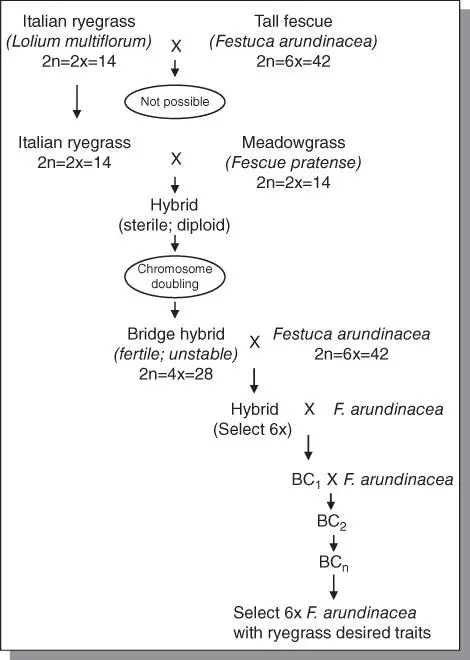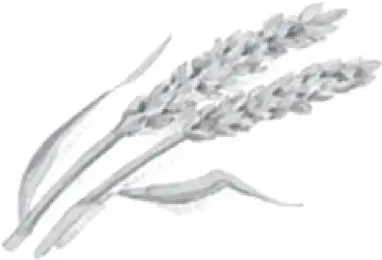Overcoming the problem of inadequate hybrid seed developmentAbnormal embryo or endosperm development following a wide cross may be overcome by using proper parent selection and reciprocal crossing as previously described. In addition, the technique of embryo rescue is an effective and common technique. The embryo is aseptically extracted and nurtured into a full plant under tissue culture conditions. Overcoming lack of vigor of the hybridHybrids may lack the vigor to grow properly to flower and produce seed. Techniques such as proper parent selection, reciprocal crossing, and grafting the hybrid onto one of the parents may help.Overcoming hybrid sterilitySterility in hybrids often stems from meiotic complications due to lack of appropriate pairing partners. Sterility may be overcome by doubling the chromosome number of the hybrid to create pairing mates for all chromosomes, and hence produce viable gametes.

Figure 6.3 In vitro fusion of protoplast cells of tomato and potato to create and intergeneric hybrid, pomato or topato.
Bridge crossingis a technique of indirectly crossing two parents that differ in ploidy levels through a transitional or an intermediate cross ( Figure 6.4). For example, R. C. Buckner and his colleagues succeeded in crossing the diploid Italian ryegrass ( Lolium multiflorum , 2 n = 2x = 14) with the hexaploid tall fescue ( Festuca arundinacea , 2 n = 6x = 42) via the bridge cross technique. The intermediate cross was between L. multiflorum and diploid meadow fescue ( Festuca pratensis , 2 n = 2x = 14). The resulting embryo was rescued and the chromosome number doubled to produce a fertile but genetically unstable tetraploid hybrid (ryegrass‐meadow fescue). Using tall fescue as recipient, the L. multiflorum x F. pratensis product was backcrossed to tall fescue, resulting in the transfer of genes from L. multiflorum to F. arundinacea . A 42‐chromosome cultivar of tall fescue with certain Italian ryegrass traits was eventually recovered and stabilized. Another example of a successful bridge cross is Allium cepa receiving genes from A. fistulosum through the A. roylei bridge.

Figure 6.4An example of a bridge cross. In order to hybridize Italian ryegrass and tall fescue, the breeder may first make an intermediary cross with meadowgrass, followed by chromosome doubling.
Key references and suggested reading
1 Chandler, J.M. and Beard, B.H. (1983). Embryo culture of Helianthus hybrids. Crop Science 23: 1004–1007.
2 Forsberg, R.A. (ed.) (1985). Triticale. Madison, WI: Crop Science of America Special Publication No.9. American Society of Agronomy.
3 Morrison, L.A., Riera‐Lizaraza, O., Cremieux, L., and Mallory‐Smith, C.A. (2002). Jointed goatgrass (Aegilops cylindrica Host) × wheat (Triticum aestivum L.) hybrids: hybridization dynamics in Oregon wheat fields. Crop Science 42: 1863–1872.
4 Singh, A.K., Moss, J.P., and Smartt, J. (1990). Ploidy manipulations for interspecific gene transfer. Advances in Agronomy 43: 199–240.
5 Stalker, H.T. (1980). Utilization of wild species for crop improvement. Advances in Agronomy 33: 111–147.
6 Stoskopf, N.C. (1993). Plant Breeding: Theory and Practice. Boulder, CO: Westview Press.
7 Zohary, D. (1973). Gene‐pools for plant breeding. In: Agricultural Genetics (ed. R. Moav). New York: Wiley.
http://csf.colorado.edu/perma/stse/isolate.htm– Basic isolation practices for reducing or eliminating natural cross‐pollination in field crossing.
http://www.actahort.org/books/200/200_3.htm– Application of wide crosses in tomato improvement.
Outcomes assessment
Part A
Please answer the following questions true or false:
1 A hybrid is a product of unidentical parents.
2 Emasculation is undertaken to make a flower female.
3 An intergeneric cross occurs between two species.
4 Wheat is a product of a wide cross.
5 Bridge crosses are used to facilitate crosses between two parents of identical ploidy levels.
Please answer the following questions:
1 What is hybridization?
2 What are wide crosses?
3 Give three specific reasons why wide crosses may be undertaken.
4 Explain the phenomenon of linkage drag.
5 Give examples of major crops that arose through wide crosses.
Please write a brief essay on each of the following topics:
1 Discuss the basic steps in artificial hybridization.
2 Discuss the challenges of wide crosses.
3 Discuss the techniques used for overcoming the challenges to wide crosses.
4 Discuss the technique of bridge crossing.
5 Discuss the genetic issues in hybridization.
 7 Clonal propagation and in vitro culture
7 Clonal propagation and in vitro culture
Purpose and expected outcomes
Conventional plant breeding entails sexual recombination between plants to obtain novel and useful combinations of traits in the resulting new product that can be reproduced more or less “true to type.” Clonal propagation on the other hand does not entail recombination, but rather the asexual multiplication of plants such that uniformity and identity are preserved intact. Plant propagators and horticulturists commonly use clonal propagation in their operations. Sometimes, plant breeders need a large number of clones for genetic studies. Modern plant breeding tools such as biotechnology include the use of techniques for generating clones and for genetic modification under aseptic conditions.
After completing this chapter, the student should be able to discuss:
1 Micropropagation and its applications in breeding.
2 The importance of cell and tissue culture in plant breeding.
3 The characteristics of asexual propagation that have breeding implications.
4 Apomixis and the breeding of apomictic species.
5 The advantages and limitations of clonal propagation.
In biology, a clone is an organism whose genetic information is identical to that of the parent organism (progenitor) from which it was created. In plants, a clone means a genetically uniform plant material derived from a single individual and propagated exclusively by vegetative (non‐seed) methods. Clones are not produced via recombination and meiosis, but from replication and mitosis. Plant breeders generally make a cross to obtain from true seeds a segregating progeny that will be followed by cycles of clonal reproduction, during which the superior types will be maintained, and the inferior types discarded. There is therefore no further genetic segregation during these cycles of clonal reproduction (in contrast to sexual progeny obtained from crosses between homozygous autogamous parents and allogamous populations).
7.2 Clones, inbred lines, and pure lines
As previously discussed, plants may be naturally sexually or asexually propagated. Further, sexually propagated species may be self‐fertilized or cross‐fertilized. These natural modes of reproduction have implications in the genetic structure and constitution of plants and breeding implications as already discussed. Plant breeders are able to manipulate the natural reproductive systems of species to develop plants that have atypical genetic constitution. The terms pure line, inbred line, and cloneare applied to materials developed by plant breeders to connote sameness of genetic constitution in some fashion. However, there are some significant distinctions among them.
Читать дальше



 7 Clonal propagation and in vitro culture
7 Clonal propagation and in vitro culture










